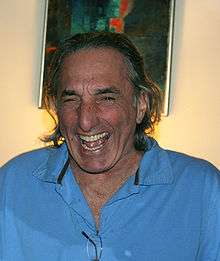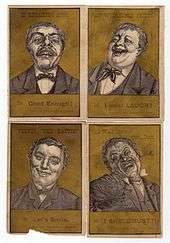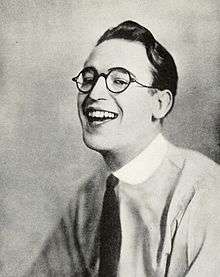Laughter
Laughter is a physical reaction in humans consisting usually of rhythmical, often audible contractions of the diaphragm and other parts of the respiratory system resulting most commonly in forms of "hee-hee" or "ha-ha". It is a response to certain external or internal stimuli. Laughter can arise from such activities as being tickled,[1] or from humorous stories or thoughts.[2] Most commonly, it is considered a auditory expression of a number of positive emotional states, such as joy, mirth, happiness, relief, etc. On some occasions, however, it may be caused by contrary emotional states such as embarrassment, surprise, or confusion such as nervous laughter or courtesy laugh. Age, gender, education, language, and culture are all indicators[3] as to whether a person will experience laughter in a given situation. Some other species of primate (chimpanzees, gorillas and orangutans) show laughter-like vocalizations in response to physical contact such as wrestling, play chasing or tickling.

Laughter is a part of human behavior regulated by the brain, helping humans clarify their intentions in social interaction and providing an emotional context to conversations. Laughter is used as a signal for being part of a group—it signals acceptance and positive interactions with others. Laughter is sometimes seen as contagious, and the laughter of one person can itself provoke laughter from others as a positive feedback.[4]
The study of humor and laughter, and its psychological and physiological effects on the human body, is called gelotology.
Nature
Laughter might be thought of as an audible expression or appearance of excitement, an inward feeling of joy and happiness. It may ensue from jokes, tickling, and other stimuli completely unrelated to psychological state, such as nitrous oxide. One group of researchers speculated that noises from infants as early as 16 days old may be vocal laughing sounds or laughter,[5] however the weight of the evidence supports its appearance at 15 weeks to four months of age.
Laughter researcher Robert Provine said: "Laughter is a mechanism everyone has; laughter is part of universal human vocabulary. There are thousands of languages, hundreds of thousands of dialects, but everyone speaks laughter in pretty much the same way." Babies have the ability to laugh before they ever speak. Children who are born blind and deaf still retain the ability to laugh.[6]
Provine argues that "Laughter is primitive, an unconscious vocalization." Provine argues that it probably is genetic. In a study of the "Giggle Twins", two happy twins who were separated at birth and only reunited 43 years later, Provine reports that "until they met each other, neither of these exceptionally happy ladies had known anyone who laughed as much as they did." They reported this even though they had been brought together by their adoptive parents, who they indicated were "undemonstrative and dour". He indicates that the twins "inherited some aspects of their laugh sound and pattern, readiness to laugh, and maybe even taste in humor".[7]
Norman Cousins developed a recovery program incorporating megadoses of Vitamin C, along with a positive attitude, love, faith, hope, and laughter induced by Marx Brothers films. "I made the joyous discovery that ten minutes of genuine belly laughter had an anesthetic effect and would give me at least two hours of pain-free sleep," he reported. "When the pain-killing effect of the laughter wore off, we would switch on the motion picture projector again and not infrequently, it would lead to another pain-free interval."[8][9]
Scientists have noted the similarity in forms of laughter induced by tickling among various primates, which suggests that laughter derives from a common origin among primate species.[10][11]
A very rare neurological condition has been observed whereby the sufferer is unable to laugh out loud, a condition known as aphonogelia.[12]
The brain


Neurophysiology indicates that laughter is linked with the activation of the ventromedial prefrontal cortex, that produces endorphins.[13] Scientists have shown that parts of the limbic system are involved in laughter. This system is involved in emotions and helps us with functions necessary for humans' survival. The structures in the limbic system that are involved in laughter are the hippocampus and the amygdala.[14]
The December 7, 1984, Journal of the American Medical Association describes the neurological causes of laughter as follows:
- "Although there is no known 'laugh center' in the brain, its neural mechanism has been the subject of much, albeit inconclusive, speculation. It is evident that its expression depends on neural paths arising in close association with the telencephalic and diencephalic centers concerned with respiration. Wilson considered the mechanism to be in the region of the mesial thalamus, hypothalamus, and subthalamus. Kelly and co-workers, in turn, postulated that the tegmentum near the periaqueductal grey contains the integrating mechanism for emotional expression. Thus, supranuclear pathways, including those from the limbic system that Papez hypothesised to mediate emotional expressions such as laughter, probably come into synaptic relation in the reticular core of the brain stem. So while purely emotional responses such as laughter are mediated by subcortical structures, especially the hypothalamus, and are stereotyped, the cerebral cortex can modulate or suppress them."
Some drugs are well known for their laughter-facilitating properties (e. g. ethanol and cannabis), while the others, like salvinorin A (the active ingredient of Salvia divinorum), can even induce bursts of uncontrollable laughter.[15]
A research article was published December 1, 2000 on the psycho-evolution of laughter (Panksepp 2000).[16]
Health
A link between laughter and healthy function of blood vessels was first reported in 2005 by researchers at the University of Maryland Medical Center with the fact that laughter causes the dilatation of the inner lining of blood vessels, the endothelium, and increases blood flow.[17] Drs. Michael Miller (University of Maryland) and William Fry (Stanford) theorize that beta-endorphin like compounds released by the hypothalamus activate receptors on the endothelial surface to release nitric oxide, thereby resulting in dilation of vessels. Other cardioprotective properties of nitric oxide include reduction of inflammation and decreased platelet aggregation.[18]
Laughter has proven beneficial effects on various other aspects of biochemistry. It has been shown to lead to reductions in stress hormones such as cortisol and epinephrine. When laughing the brain also releases endorphins that can relieve some physical pain.[19] Laughter also boosts the number of antibody-producing cells and enhances the effectiveness of T-cells, leading to a stronger immune system.[20] A 2000 study found that people with heart disease were 40 percent less likely to laugh and be able to recognize humor in a variety of situations, compared to people of the same age without heart disease.[21]
In interaction
A number of studies using methods of conversation analysis and discourse analysis have documented the systematic workings of laughter in a variety of interactions, from casual conversations to interviews, meetings, and therapy sessions.[22] Working with recorded interactions, researchers have created detailed transcripts that indicate not only the presence of laughter but also features of its production and placement.
These studies challenge several widely held assumptions about the nature of laughter. Contrary to notions that it is spontaneous and involuntary, research documents that laughter is sequentially organized and precisely placed relative to surrounding talk. Far more than merely a response to humor, laughter often works to manage delicate and serious moments. More than simply an external behavior “caused” by an inner state, laughter is highly communicative and helps accomplish actions and regulate relationships.
Causes

Common causes for laughter are sensations of joy and humor; however, other situations may cause laughter as well.
A general theory that explains laughter is called the relief theory. Sigmund Freud summarized it in his theory that laughter releases tension and "psychic energy". This theory is one of the justifications of the beliefs that laughter is beneficial for one's health.[23] This theory explains why laughter can be used as a coping mechanism when one is upset, angry or sad.
Philosopher John Morreall theorizes that human laughter may have its biological origins as a kind of shared expression of relief at the passing of danger. Friedrich Nietzsche, by contrast, suggested laughter to be a reaction to the sense of existential loneliness and mortality that only humans feel.
For example: a joke creates an inconsistency and the audience automatically tries to understand what the inconsistency means; if they are successful in solving this 'cognitive riddle' and they realize that the surprise was not dangerous, they laugh with relief. Otherwise, if the inconsistency is not resolved, there is no laugh, as Mack Sennett pointed out: "when the audience is confused, it doesn't laugh." This is one of the basic laws of a comedian, referred to as "exactness". It is important to note that sometimes the inconsistency may be resolved and there may still be no laugh. Because laughter is a social mechanism, an audience may not feel as if they are in danger, and the laugh may not occur. In addition, the extent of the inconsistency (and aspects of its timing and rhythm) has to do with the amount of danger the audience feels, and how hard or long they laugh.
Laughter can also be brought on by tickling. Although most people find it unpleasant, being tickled often causes heavy laughter, thought to be an (often uncontrollable) reflex of the body.[24][25]
Types
.jpg)
Laughter can be classified according to:
- intensity: the chuckle, the titter, the giggle, the chortle, the cackle, the belly laugh, the sputtering burst.[26][27]
- the overtness: snicker, snigger, guffaw.
- the respiratory pattern involved: snort.
- the emotion it is expressed with: relief, mirth, joy, happiness, embarrassment, apology, confusion, nervous laughter, paradoxical laughter, courtesy laugh, evil laughter.
- the sequence of notes or pitches it produces. It may be subjectively measured on the Andreoli scale for heartiness, with a higher measure denoting greater robustness, generally in a manly aspect.
There are 10 different types of laughter:[28]
- Etiquette laughter: even when things aren't funny, people rely on laughter to get along with others.
- Contagious laughter: a chain reaction of laughter.
- Nervous laughter: anxiety can oftentimes trigger laughter in a subconscious attempt to reduce stress and calm down.
- Belly laughter: when something is truly hilarious, people clutch their bellies and gasp for air.
- Silent laughter: involves the same type of deep breathing that comes with belly laughter but it makes no noise.
- Stress-relieving laughter: encompasses many forms, but occurs mostly in an outburst.
- Pigeon laughter: laughing without opening your mouth with your lips sealed, producing a humming sound.
- Snorting laughter: when laughter occurs through the nose.
- Canned laughter: commonly referred to as the "laugh track," real laughter oftentimes heard in the background of TV sitcoms.
- Cruel laughter: laughing at others' expense.
Human laugh structure and anatomy
A normal laugh has the structure of "ha-ha-ha" or "ho-ho-ho". It is unnatural, and one is physically unable, to have a laugh structure of "ha-ho-ha-ho". The usual variations of a laugh most often occur in the first or final note in a sequence- therefore, "ho-ha-ha" or "ha-ha-ho" laughs are possible. Normal note durations with unusually long or short "inter-note intervals" do not happen due to the result of the limitations of our vocal cords. This basic structure allows one to recognize a laugh despite individual variants.[29]
It has also been determined that eyes moisten during laughter as a reflex from the tear glands.[20]
Negative aspects
Laughter is not always a pleasant experience and is associated with several negative phenomena. Excessive laughter can lead to cataplexy, and unpleasant laughter spells, excessive elation, and fits of laughter can all be considered negative aspects of laughter. Unpleasant laughter spells, or "sham mirth," usually occur in people who have a neurological condition, including patients with pseudobulbar palsy, multiple sclerosis and Parkinson's disease. These patients appear to be laughing out of amusement but report that they are feeling undesirable sensations "at the time of the punch line".
Excessive elation is a common symptom associated with manic-depressive psychoses and mania/hypomania. Those who suffer from schizophrenic psychoses seem to suffer the opposite—they do not understand humor or get any joy out of it. A fit describes an abnormal time when one cannot control the laughter or one's body, sometimes leading to seizures or a brief period of unconsciousness. Some believe that fits of laughter represent a form of epilepsy.[30]
Laughter therapy
Laughter has been used as a therapeutic tool for many years because it is a natural form of medicine. Laughter is available to everyone and it provides benefits to a person's physical, emotional, and social well being. Some of the benefits of using laughter therapy are that it can relieve stress and relax the whole body.[31] It can also boost the immune system and release endorphins to relieve pain.[32] Additionally, laughter can help prevent heart disease by increasing blood flow and improving the function of blood vessels.[33] Some of the emotional benefits include diminishing anxiety or fear, improving overall mood, and adding joy to one's life. Laughter is also known to reduce allergic reactions in a preliminary study related to dust mite allergy sufferers.[34]
Laughter therapy also has some social benefits, such as strengthening relationships, improving teamwork and reducing conflicts, and making oneself more attractive to others. Therefore, whether a person is trying to cope with a terminal illness or just trying to manage their stress or anxiety levels, laughter therapy can be a significant enhancement to their life.[35][36]
Ramon Mora-Ripoll in his study on The Therapeutic Value Of Laughter In Medicine, stated that laughter therapy is an inexpensive and simple tool that can be used in patient care.[37] It is a tool that is only beneficial when experienced and shared. Care givers need to recognize the importance of laughter and possess the right attitude to pass it on. He went on to say that since this type of therapy is not widely practiced, health care providers will have to learn how to effectively use it. In another survey, researchers looked at how Occupational Therapists and other care givers viewed and used humor with patients as a means of therapy.[38] Many agreed that while they believed it was beneficial to the patients, the proper training was lacking in order to effectively use It.[38] Even though laughter and humor has been used therapeutically in medical conditions, according to Mora-Ripoll, there was not enough data to clearly establish that laughter could be used as an overall means of healing. It did suggest that additional research was still needed since "well-designed randomized controlled trials have not been conducted to date validating the therapeutic efficacy of laughter."[37]
In 2017, an institution in Japan conducted an open-label randomized controlled trial to evaluate the effects of laughter therapy on quality of life in patients with cancer.[39] The study used laughter yoga, comedy, clown and jokes. The result showed that laughter therapy was helpful in improving quality of life and cancer symptoms in some areas for cancer survivors. Improvements were seen in the area of depression, anxiety and stress levels. There were limited harmful side effects. Laughter therapy should be used in conjunction with other cancer treatment.[39]
Research

Laughter in literature, although considered understudied by some,[40] is a subject that has received attention in the written word for millennia. The use of humor and laughter in literary works has been studied and analyzed by many thinkers and writers, from the Ancient Greek philosophers onward. Henri Bergson's Laughter: An Essay on the Meaning of the Comic (Le rire, 1901) is a notable 20th-century contribution.
Ancient Greece
Herodotus
For Herodotus, laughers can be distinguished into three types:[41]
- Those who are innocent of wrongdoing, but ignorant of their own vulnerability
- Those who are mad
- Those who are overconfident
According to Donald Lateiner, Herodotus reports about laughter for valid literary and historiological reasons. "Herodotus believes either that both nature (better, the gods' direction of it) and human nature coincide sufficiently, or that the latter is but an aspect or analogue of the former, so that to the recipient the outcome is suggested."[41] When reporting laughter, Herodotus does so in the conviction that it tells the reader something about the future and/or the character of the person laughing. It is also in this sense that it is not coincidental that in about 80% of the times when Herodotus speaks about laughter it is followed by a retribution. "Men whose laughter deserves report are marked, because laughter connotes scornful disdain, disdain feeling of superiority, and this feeling and the actions which stem from it attract the wrath of the gods."[41]
Modern laughter and humor

There is a wide range of experiences with laughter. A 1999 study by two humor researchers asked 80 people to keep a daily laughter record, and found they laughed an average of 18 times per day. However, their study also found a wide range, with some people laughing as many as 89 times per day, and others laughing as few as 0 times per day.[42]
Hobbes
Thomas Hobbes understood the superiority of the laughter in a much wider sense than the aesthetic and quasi-moral sense of Aristotle, the seeds of the superiority theory are definitely Greek.[43] In Hobbes' own words: "The passion of laughter is nothing else but sudden glory arising from sudden conception of some eminency in ourselves, by comparison with the infirmity of others, or with our own formerly."
Schopenhauer
Philosopher Arthur Schopenhauer devotes the 13th chapter of the first part of his major work, The World as Will and Representation, to laughter.
Nietzsche
Friedrich Nietzsche distinguishes two different purposes for the use of laughter. In a positive sense, "man uses the comical as a therapy against the restraining jacket of logic, morality and reason. He needs from time to time a harmless demotion from reason and hardship and in this sense laughter has a positive character for Nietzsche."[44] Laughter can, however, also have a negative connotation when it is used for the expression of social conflict. This is expressed, for instance, in The Gay Science: "Laughter -- Laughter means to be schadenfroh, but with clear conscience."[45]
"Possibly Nietzsche's works would have had a totally different effect, if the playful, ironical and joking in his writings would have been factored in better"[46]
Bergson
In Laughter: An Essay on the Meaning of the Comic, French philosopher Henri Bergson, renowned for his philosophical studies on materiality, memory, life and consciousness, tries to determine the laws of the comic and to understand the fundamental causes of comic situations.[47] His method consists in determining the causes of the comic instead of analyzing its effects. He also deals with laughter in relation to human life, collective imagination and art, to have a better knowledge of society.[48] One of the theories of the essay is that laughter, as a collective activity, has a social and moral role, in forcing people to eliminate their vices. It is a factor of uniformity of behaviours, as it condemns ludicrous and eccentric behaviours.[49]
Ludovici
Anthony Ludovici developed the thoughts of Hobbes and Darwin even further in The Secret of Laughter. His conviction is that there's something sinister in laughter, and that the modern omnipresence of humour and the idolatry of it are signs of societal weakness, as instinctive resort to humour became a sort of escapism from responsibility and action. Ludovici considered laughter to be an evolutionary trait and he offered many examples of different triggers for laughter with their own distinct explanations.[50]
See also
- Agelast
- Death from laughter
- Evil laughter
- Gelotology
- Laughter in animals
- Laughter Yoga
- Nervous laughter
- Paradoxical laughter
- Pathological laughing and crying
References
- Stearns, Frederic Rudolph (1972). Laughing: Physiology, Pathology, Psychology, Pathopsychology and Development. Springfield, Ill., Thomas. pp. 59–65. ISBN 978-0398024208.
- Shultz, T. R.; Horibe, F. (1974). "Development of the appreciation of verbal jokes". Developmental Psychology. 10: 13–20. doi:10.1037/h0035549.
- Olmwake, Louise (1937). "A study of sense of humor: Its relation to sex, age and personal characteristics". Journal of Applied Psychology. 21 (6): 688–704. doi:10.1037/h0055199.
- Camazine, Deneubourg, Franks, Sneyd, Theraulaz, Bonabeau, Self-Organization in Biological Systems, Princeton University Press, 2003. ISBN 0-691-11624-5 – ISBN 0-691-01211-3 (pbk.) p. 18.
- Kawakami, Kiyobumi; Takai-Kawakami, Kiyoko; Tomonaga, Masaki; Suzuki, Juri; Kusaka, Tomiyo; Okai, Takashi (2006). "Origins of smile and laughter: A preliminary study" (PDF). Early Human Development. 82 (1): 61–66. doi:10.1016/j.earlhumdev.2005.07.011. PMID 16185829. Archived from the original (PDF) on 2011-09-28.
- Gervais, Matthew; Sloan Wilson, David (2005). "The Evolution and Functions of Laughter and Humor: A Synthetic Approach". Quarterly Review of Biology. 80 (4): 395–430. doi:10.1086/498281. PMID 16519138.
- "WebMD 2002". Men.webmd.com. Retrieved 2011-12-26.
- Cousins, Norman, The Healing Heart : Antidotes to Panic and Helplessness, New York : Norton, 1983. ISBN 0-393-01816-4.
- Cousins, Norman, Anatomy of an illness as perceived by the patient : reflections on healing and regeneration, introd. by René Dubos, New York : Norton, 1979. ISBN 0-393-01252-2.
- "Tickled apes yield laughter clue", News.BBC.co.uk, June 4, 2009.
- Davila Ross, Marina; j Owren, Michael; Zimmermann, Elke (2009). "Reconstructing the Evolution of Laughter in Great Apes and Humans". Current Biology. 19 (13): 1106–1111. doi:10.1016/j.cub.2009.05.028. PMID 19500987.
- Levin, Max (1930-07-16). "Inability to Laugh Audibly: Aphonogelia". Archives of Neurology and Psychiatry. 25 (1): 157. doi:10.1001/archneurpsyc.1931.02230010169012.
- Why Laughter Feels So Good 13 September 2011 New York Times science section.
- Cardoso, Silvia Helena. "laughter". www.cerebromente.org.br.
- Turner, D.M. (August 1996). "Effects and Experiences". Salvinorin—The Psychedelic Essence of Salvia Divinorum. San Francisco, CA: Panther Press. ISBN 978-0-9642636-2-8. Retrieved 2007-05-20.
- Jaak Panksepp - The Riddle of Laughter - Neural and Psychoevolutionary Underpinnings of Joy December 1, 2000 Sage Journals Accessed October 28th, 2017
- Miller, M; Mangano, C; Park, Y; Goel, R; Plotnick, GD; Vogel, RA (2005). "Impact of cinematic viewing on endothelial function". Heart. 92 (2): 261–2. doi:10.1136/hrt.2005.061424. PMC 1860773. PMID 16415199.
- Vlachopoulos, C; Xaplanteris, P; Alexopoulos, N; Aznaouridis, K; Vasiliadou, C; Baou, K; Stefanadi, E; Stefanadis, C (2009). "Divergent effects of laughter and mental stress on arterial stiffness and central hemodynamics". Psychosom. Med. 71 (4): 446–53. doi:10.1097/PSY.0b013e318198dcd4. PMID 19251872.
- Dunbar, R. I. M.; Baron, R.; Frangou, A.; Pearce, E.; van Leeuwen, E. J. C.; Stow, J.; Partridge, G.; MacDonald, I.; Barra, V.; van Vugt, M. (2011). "Social laughter is correlated with an elevated pain threshold". Proceedings of the Royal Society B: Biological Sciences. 279 (1731): 1161–1167. doi:10.1098/rspb.2011.1373. ISSN 0962-8452. PMC 3267132. PMID 21920973.
- Smith Lee, B. (1990). Humor relations for nurse managers. Nursing Management, 21, 86.
- "Laughter is Good for Your Heart, According to a New UMMC Study". University of Maryland Medical Center.
- Glenn, P., & Holt, E. (Eds) (2013). Studies of Laughter in Interaction. London: Bloomsbury.
- M.P. Mulder, A. Nijholt (2002) "Humor Research: State of the Art", citeseer.ist.psu.edu
- "Physiology of laughter and tickling". www.tomveatch.com. Retrieved 2010-08-03.
- Robert R. Provine (1950-09-09). "Provine, Laughter". Cogweb.ucla.edu. Retrieved 2011-12-26.
- Drewniany and Jewler (2007) Creative Strategy in Advertising, 9th edition, ch.1 p.17
- Andreyev, Judith Wondering about Words: D'où Viennent Les Mots Anglais ? p.56
- "10 Different Types of Laughter". HowStuffWorks. 2009-06-04. Retrieved 2019-07-18.
- Provine, R (1996). "Laughter". American Scientist. 841: 38–47.
- Fry, W.F. (1963). Sweet Madness: A Study of Humor. Palo Alto, Ca: Pacific Books Publishers
- Berk, L. S.; Felten, D. L.; Tan, S. A.; Bittman, B. B.; Westengard, J. (2001-03-01). "Modulation of neuroimmune parameters during the eustress of humor-associated mirthful laughter". Alternative Therapies in Health and Medicine. 7 (2): 62–72, 74–76. ISSN 1078-6791. PMID 11253418.
- Bennett, Mary P.; Zeller, Janice M.; Rosenberg, Lisa; McCann, Judith (2003-04-01). "The effect of mirthful laughter on stress and natural killer cell activity". Alternative Therapies in Health and Medicine. 9 (2): 38–45. ISSN 1078-6791. PMID 12652882.
- "Humor helps your heart? How?". www.heart.org. Retrieved 2019-03-30.
- Kimata, H. (2001-02-14). "EFfect of humor on allergen-induced wheal reactions". JAMA. 285 (6): 738. doi:10.1001/jama.285.6.738. ISSN 0098-7484. PMID 11176910.
- "Laughter Therapy." Laughter Therapy: Cancer Treatment Centers of America. Cancer Treatment Centers of America, 1 January 2001. Web. accessed 28 February 2014.
- Smith, Melinda, and Jeanne Segal. "Laughter Is the Best Medicine." The Health Benefits of Humor, Helpguide.org, February 2014. Web. accessed 1 March 2014.
- Mora-Ripoll, R. (2010). "The Therapeutic Value of Laughter in Medicine". Alternatives Therapies in Health & Medicine. 16 (6): 56–64. PMID 21280463.
- Leber, Vanoli, D. A., E. G. (March–April 2001). "Therapeutic use of humor: occupational therapy clinicians perceptions and practices". American Journal of Occupational Therapy. 55 (2): 221–226. doi:10.5014/ajot.55.2.221. PMID 11761140.
- Morishima, T; Miyashiro, I; Inoue, N; Kitasaka, M; Akawa, T; Higeno, A; Matsuura, N (2019). "Laughter Therapy". The Charles Inniss Memorial Library.
- Morreall, John. Taking Laughter Seriously (1983) p.ix.
- Lateiner, Donald. No laughing matter: a literary tactic in Herodotus, Transactions of the American Philological Association, Vol. 107. (1977), pp. 173-182.
- Martin, Rod A; Kuiper, Nicholas A (1999). "Daily occurrence of laughter: Relationships with age, gender, and Type A personality". Humor. 12 (4): 355–384. doi:10.1515/humr.1999.12.4.355 – via Researchgate.
- Heyd, David. The Place of Laughter in Hobbes's Theory of Emotions, Journal of the History of Ideas, Vol. 43, No. 2. (Apr. - Jun., 1982), pp. 285-295.
- Kunnas, Tarmo. Nietzsches lachen: Eine studie über das Komische bei Nietzsche, Edition Wissenschaft & literatur, 1982, p. 42
- Nietzsche, KSA 3, p. 506
- Kunnas, Tarmo. Nietzsches lachen, p.149.
- Henri Bergson, Le Rire, Avant-Propos on Wikisource (in French)
- Bergson, Henri. Le Rire, "Préface" on Wikisource (in French)
- Bergson, Henri. Laughter: An Essay on the Meaning of the Comic, Chapter I (II) - online version on Project Gutenberg
- "The Secret Of Laughter Preface, Introduction". www.anthonymludovici.com.
Further reading
- Bachorowski, J.-A., Smoski, M.J., & Owren, M.J. The acoustic features of human laughter. Journal of the Acoustical Society of America, 110 (1581) 2001
- Bakhtin, Mikhail (1941). Rabelais and His World. Bloomington: Indiana University Press. ISBN 978-0-253-34830-2.
- Chapman, Antony J.; Foot, Hugh C.; Derks, Peter (editors), Humor and Laughter: Theory, Research, and Applications, Transaction Publishers, 1996. ISBN 1-56000-837-7. Books.google.com
- Cousins, Norman, Anatomy of an Illness As Perceived by the Patient, 1979.
- Davila-Ross, M.; Allcock, B.; Thomas, C.; Bard, K.A. (2011). "Aping expressions? Chimpanzees produce distinct laugh types when responding to laughter of others". Emotion. 11 (5): 1013–1020. doi:10.1037/a0022594. PMID 21355640.
- Fried, I., Wilson, C.L., MacDonald, K.A., and Behnke EJ. Electric current stimulates laughter. Nature, 391:650, 1998 (see patient AK)
- Goel, V. & Dolan, R. J. The functional anatomy of humor: segregating cognitive and affective components. Nature Neuroscience 3, 237 - 238 (2001).
- Greig, John Young Thomson, The Psychology of Comedy and Laughter, New York, Dodd, Mead and company, 1923.
- Hennefeld, Maggie (December 2016). "Death from Laughter, Female Hysteria, and Early Cinema". differences: A Journal of Feminist Cultural Studies. 27 (3): 45–92. doi:10.1215/10407391-3696631.CS1 maint: ref=harv (link)
- Knight, Chris, Does laughter hold the key to human consciousness? Aeon Magazine February 2019.
- Marteinson, Peter, On the Problem of the Comic: A Philosophical Study on the Origins of Laughter, Legas Press, Ottawa, 2006. utoronto.ca
- Miller, M; Mangano, C; Park, Y; Goel, R; Plotnick, GD; Vogel, RA (2006). "Impact of cinematic viewing on endothelial function". Heart. 92 (2): 261–2. doi:10.1136/hrt.2005.061424. PMC 1860773. PMID 16415199.
- Provine, R. R., Laughter. American Scientist, V84, 38:45, 1996. ucla.edu
- Provine, Robert R. (2001). Laughter: A Scientific Investigation. ISBN 978-0141002255.
- Quentin Skinner (2004). "Hobbes and the Classical Theory of Laughter" (PDF). Archived from the original (PDF) on 2012-10-18. Retrieved 2006-10-23. Cite journal requires
|journal=(help) included in book: Sorell, Tom; Luc Foisneau (2004). "6" (PDF). Leviathan After 350 Years. Oxford University Press. pp. 139–66. ISBN 978-0-19-926461-2. - Raskin, Victor, Semantic Mechanisms of Humor (1985).
- MacDonald, C., "A Chuckle a Day Keeps the Doctor Away: Therapeutic Humor & Laughter" Journal of Psychosocial Nursing and Mental Health Services(2004) V42, 3:18-25. psychnurse.org
- Kawakami, K., et al., Origins of smile and laughter: A preliminary study Early Human Development (2006) 82, 61–66. kyoto-u.ac.jp
- Johnson, S., Emotions and the Brain Discover (2003) V24, N4. discover.com
- Panksepp, J., Burgdorf, J.,"Laughing" rats and the evolutionary antecedents of human joy? Physiology & Behavior (2003) 79:533-547. psych.umn.edu
- Milius, S., Don't look now, but is that dog laughing? Science News (2001) V160 4:55. sciencenews.org
- Simonet, P., et al., Dog Laughter: Recorded playback reduces stress related behavior in shelter dogs 7th International Conference on Environmental Enrichment (2005). petalk.org
- Discover Health (2004) Humor & Laughter: Health Benefits and Online Sources, helpguide.org
- Klein, A. The Courage to Laugh: Humor, Hope and Healing in the Face of Death and Dying. Los Angeles, CA: Tarcher/Putman, 1998.
- Ron Jenkins Subversive laughter (New York, Free Press, 1994), 13ff
- Bogard, M. Laughter and its Effects on Groups. New York, New York: Bullish Press, 2008.
- Humor Theory. The formulae of laughter by Igor Krichtafovitch, Outskitspress, 2006, ISBN 978-1-59800-222-5
- Hans-Georg Moeller und Günter Wohlfart (Hrsg.): Laughter in Eastern and Western Philosophies. Verlag Karl Alber, Freiburg / München 2010. ISBN 978-3-495-48385-5
External links
| Wikimedia Commons has media related to laughing. |
| Wikiquote has quotations related to: Laughter |
| Look up laughter in Wiktionary, the free dictionary. |
- Did laughter make the mind?, Aeon magazine
- The Origins of Laughter, chass.utoronto.ca
- Human laughter up to 16 million years old, cosmosmagazine.com
- More information about Gelotology from the University of Washington, faculty.Washington.edu
- WNYC's Radio Lab radio show: Is Laughter just a Human Thing?, wnyc.org
- Transcriptions of laughter, writtensound.com
- Recordings of people laughing, 99 audio examples of human laughter
- Comprehensive summary of research on the benefits of laughter